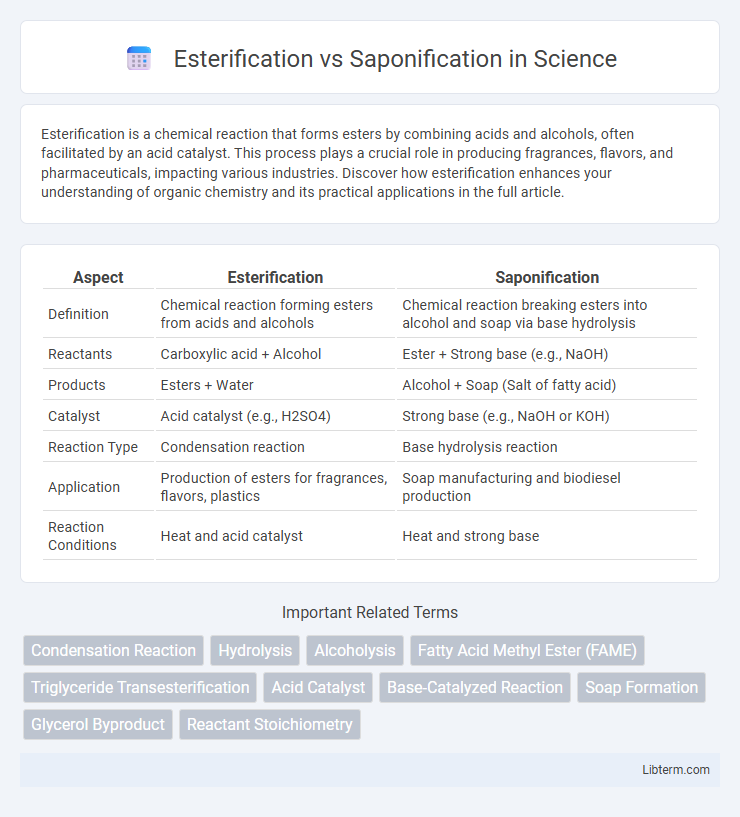Esterification is a chemical reaction that forms esters by combining acids and alcohols, often facilitated by an acid catalyst. This process plays a crucial role in producing fragrances, flavors, and pharmaceuticals, impacting various industries. Discover how esterification enhances your understanding of organic chemistry and its practical applications in the full article.
Table of Comparison
| Aspect | Esterification | Saponification |
|---|---|---|
| Definition | Chemical reaction forming esters from acids and alcohols | Chemical reaction breaking esters into alcohol and soap via base hydrolysis |
| Reactants | Carboxylic acid + Alcohol | Ester + Strong base (e.g., NaOH) |
| Products | Esters + Water | Alcohol + Soap (Salt of fatty acid) |
| Catalyst | Acid catalyst (e.g., H2SO4) | Strong base (e.g., NaOH or KOH) |
| Reaction Type | Condensation reaction | Base hydrolysis reaction |
| Application | Production of esters for fragrances, flavors, plastics | Soap manufacturing and biodiesel production |
| Reaction Conditions | Heat and acid catalyst | Heat and strong base |
Introduction to Esterification and Saponification
Esterification is a chemical reaction between an acid, usually a carboxylic acid, and an alcohol, producing an ester and water, commonly catalyzed by acids like sulfuric acid. Saponification refers to the hydrolysis of esters, particularly triglycerides, using a strong base such as sodium hydroxide, resulting in glycerol and soap, a crucial process in soap manufacturing. Both reactions involve the transformation of esters, but esterification forms esters while saponification breaks them down.
Defining Esterification: Process and Principles
Esterification is a chemical reaction where an acid, typically a carboxylic acid, reacts with an alcohol to form an ester and water, catalyzed commonly by acids like sulfuric acid. The process involves the nucleophilic attack of the alcohol's hydroxyl group on the carbonyl carbon of the acid, resulting in the elimination of water and formation of the ester bond. This reaction is reversible and reaches equilibrium, dependent on factors such as temperature, concentration, and catalyst presence.
Understanding Saponification: Basics and Mechanism
Saponification is a chemical reaction between a fat or oil and a strong base, typically sodium hydroxide, resulting in the formation of glycerol and soap, which are salts of fatty acids. The mechanism involves the nucleophilic attack of the hydroxide ion on the ester bond of triglycerides, leading to the cleavage of ester linkages and release of fatty acid salts. Understanding saponification is crucial for industries such as soap manufacturing, where the control of reaction conditions impacts soap quality and properties.
Key Chemical Reactions: Esterification vs Saponification
Esterification is a chemical reaction where a carboxylic acid reacts with an alcohol, producing an ester and water, often catalyzed by an acid like sulfuric acid. In contrast, saponification involves the hydrolysis of esters by a strong base, such as sodium hydroxide, yielding an alcohol and a carboxylate salt, commonly known as soap. These reactions are fundamental in organic chemistry, with esterification forming esters used in fragrances and saponification crucial for soap making.
Catalysts and Reaction Conditions
Esterification typically requires an acid catalyst, such as sulfuric acid or hydrochloric acid, and involves heating under reflux to drive the equilibrium towards ester formation. Saponification, on the other hand, uses a strong base catalyst like sodium hydroxide or potassium hydroxide at elevated temperatures, leading to hydrolysis of esters into alcohol and soap. Reaction conditions for esterification favor acidic, high-temperature environments to remove water, while saponification occurs under basic, aqueous conditions to ensure complete ester breakdown.
Industrial Applications of Esterification
Esterification plays a crucial role in industrial applications such as the synthesis of plastics, pharmaceuticals, and perfumery, where it produces esters used as solvents, plasticizers, and flavoring agents. This acid-catalyzed reaction between carboxylic acids and alcohols enables the large-scale manufacture of biodegradable polymers and synthetic lubricants. In contrast, saponification, a base-catalyzed hydrolysis of esters, is primarily exploited in soap production, converting triglycerides into glycerol and fatty acid salts.
Saponification in Soap Production
Saponification is a chemical reaction between triglycerides and a strong base, typically sodium hydroxide, producing soap and glycerol. This process breaks ester bonds in fats or oils to yield fatty acid salts, which act as surfactants in soap. Unlike esterification, saponification is essential for converting natural fats into solid soap products with cleansing properties.
Comparison of Products and Byproducts
Esterification produces esters and water as byproducts through the reaction of an acid and an alcohol, while saponification yields soap and glycerol by breaking down triglycerides with a strong base. The esters formed in esterification are typically fragrant compounds used in flavors and fragrances, whereas the soap produced in saponification serves as effective cleansing agents. Water is the only byproduct in esterification, whereas saponification generates glycerol as a valuable secondary product.
Environmental Impact and Safety Considerations
Esterification typically produces biodegradable esters used in green solvents and fragrances, minimizing environmental toxicity, whereas saponification generates soap and glycerol, both of which are biodegradable but may involve strong alkalis that require cautious handling. The mild reaction conditions in esterification reduce energy consumption and hazardous waste compared to saponification, which often uses caustic alkalis posing risks of chemical burns and environmental alkalinity. Proper management of saponification effluents is critical to prevent aquatic toxicity, while esterification's controlled processes offer safer operational profiles and lower environmental footprints.
Conclusion: Choosing Between Esterification and Saponification
Esterification is ideal for synthesizing esters from carboxylic acids and alcohols, commonly used in fragrance and polymer industries, while saponification is preferred for producing soaps and glycerol by hydrolyzing esters with a strong base. The choice depends on the desired product: esterification facilitates the formation of diverse ester compounds, whereas saponification efficiently breaks down esters into fatty acid salts and alcohols. Process conditions, reactant availability, and end-use applications are critical factors influencing the selection between these chemical reactions.
Esterification Infographic

 libterm.com
libterm.com